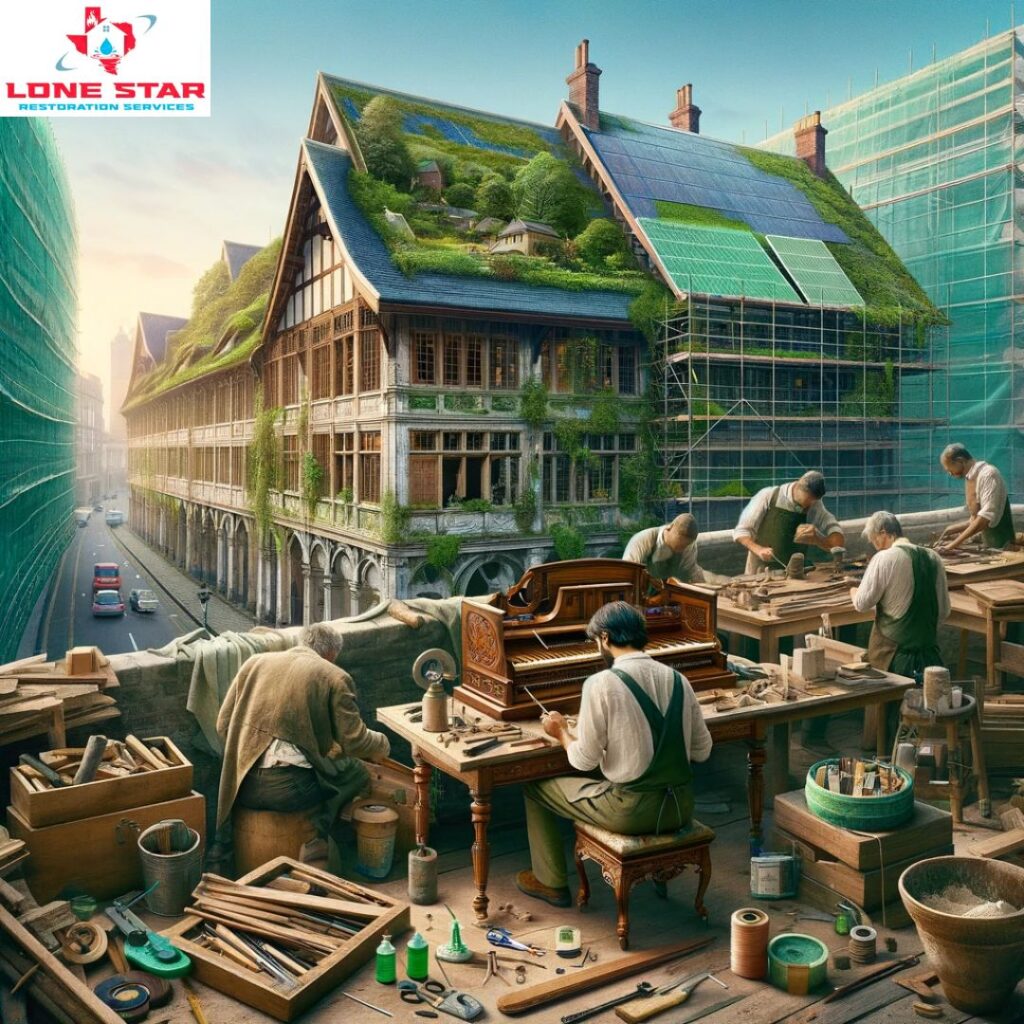Sustainable Crafting: Embracing Eco-Friendly Practices in Contemporary Restoration
In an era where environmental consciousness is not just a trend but a necessity, the field of restoration is undergoing a significant transformation. At Lone Star Restoration, we recognize that preserving our past and protecting our planet are not mutually exclusive goals. This realization is at the heart of our latest endeavors, where we merge the timeless art of restoration with the pressing need for sustainability. In this blog, we’ll delve into the exciting world of eco-friendly practices in modern restoration, exploring how these methods not only safeguard our heritage but also our environment.
From the repurposing of ancient beams to the application of low-VOC paints, the journey of sustainable restoration is as intricate as it is important. We’re here to unravel the complexities and showcase the beauty of restoration work that honors both history and the health of our planet. Join us as we explore the innovative materials, techniques, and technologies that are redefining the restoration industry, paving the way for a greener, more responsible approach to bringing new life to old treasures.
The Importance of Sustainability in Restoration
As we navigate through the 21st century, the concept of sustainability has become a cornerstone in all industries, including the field of restoration. The restoration of buildings, artifacts, and historical sites is traditionally viewed through the lens of preserving cultural heritage. However, this process often involves materials and methods that can be detrimental to the environment. It’s here that the role of sustainability becomes pivotal.
Sustainability in restoration goes beyond just using eco-friendly materials. It encompasses a holistic approach that considers the environmental impact of every aspect of the restoration process – from the sourcing of materials to the methods employed and the long-term preservation of the restored object or structure. The aim is not only to protect and revive historical structures but also to ensure that these efforts contribute positively to the environment rather than detract from it.
This approach is especially crucial today, as we face global challenges like climate change and resource depletion. Traditional restoration methods often involve the use of chemicals and processes that emit harmful pollutants, consume a significant amount of energy, and generate waste. By adopting sustainable practices, restorers can significantly reduce the carbon footprint of their projects, minimize waste, and conserve resources. Additionally, sustainable restoration can often reveal innovative practices that are both cost-effective and beneficial for the longevity of the restored item or structure.
Furthermore, embracing sustainability in restoration resonates with the growing public interest in environmental responsibility. It aligns with the values of a society increasingly concerned with how their choices impact the world. By integrating sustainable practices, restoration professionals not only contribute to the preservation of historical artifacts and buildings but also to the creation of a more environmentally conscious legacy for future generations.
As we continue to explore the realms of sustainable restoration, it becomes clear that this approach is not just a choice but a responsibility. In the following sections, we’ll delve deeper into the specific materials and techniques that embody this eco-friendly ethos in restoration, demonstrating how sustainability and preservation can go hand in hand.
Eco-Friendly Materials in Mordan Restoration
The choice of materials plays a pivotal role in sustainable restoration. In our quest to harmonize historical preservation with environmental stewardship, we at Lone Star Restoration prioritize the use of eco-friendly materials. These materials are not only less harmful to the environment but often offer superior durability and aesthetic appeal.
One key aspect of sustainable materials is their source. We prioritize materials that are locally sourced, reducing the carbon footprint associated with transportation. Additionally, these local materials often have historical significance, allowing a more authentic restoration that resonates with the site’s original character.
Reclaimed and recycled materials are also at the forefront of our sustainable approach. Wood from old structures, recycled glass, and repurposed metals not only reduce waste but also add a unique story and character to the restoration project. These materials, having stood the test of time, bring an authenticity and durability that is hard to replicate with new materials.
In terms of paints and finishes, we opt for products with low volatile organic compounds (VOCs). Traditional paints release harmful chemicals into the environment, contributing to air pollution and posing health risks. Low-VOC alternatives provide a safer option for both our workers and the environment, without compromising on quality or aesthetic appeal.
The use of natural, biodegradable materials is another cornerstone of our practice. Materials like natural lime plaster, hemp, and flax offer excellent performance in insulation and durability while being entirely biodegradable. These materials work in harmony with the environment, gradually decomposing without leaving harmful residues.
Furthermore, modern advancements have brought about innovative sustainable materials that offer enhanced performance. For instance, bio-based foams and insulators provide superior energy efficiency, helping to reduce the building’s carbon footprint long after the restoration is complete.
The incorporation of these eco-friendly materials into restoration projects is more than just a trend; it’s a commitment to preserving our past in a way that ensures a sustainable future. As we continue to explore and utilize these materials, we contribute to a more responsible and conscientious approach to restoration, one that respects both our heritage and our planet.
Innovative Green Techniques and Technologies
The evolution of restoration practices is not only about the materials used but also about how they are applied. At Lone Star Restoration, we harness innovative green techniques and technologies that significantly reduce environmental impact while maintaining, and often enhancing, the quality of our work.
One such technique is the use of energy-efficient tools and machinery. These devices consume less power and reduce emissions, making the restoration process more sustainable. Additionally, precision tools enable us to work more efficiently, minimizing waste and damage to original materials.
Digital technologies, like 3D scanning and modeling, play a crucial role in sustainable restoration. These tools allow us to accurately assess and plan restoration projects, reducing the need for invasive procedures. By creating detailed digital replicas, we can preserve the integrity of the original structure while planning necessary interventions with minimal impact.
Another green technique involves the use of non-toxic cleaning and conservation methods. Traditional restoration often relies on harsh chemicals that can be damaging to the environment and human health. By adopting gentler, eco-friendly alternatives, we ensure a safer process for both our team and the surrounding ecosystem.
Water conservation is also a critical component of our green restoration practices. Techniques like rainwater harvesting and the use of water-efficient systems help in minimizing water usage, an essential aspect in areas facing water scarcity.
Case Studies: Successful Sustainable Restoration Projects
To illustrate the effectiveness of these sustainable practices, let’s look at a few case studies where Lone Star Restoration has successfully implemented eco-friendly restoration.
One notable project is the restoration of a historic Texas farmhouse. By using locally sourced reclaimed wood and low-VOC paints, we not only preserved the building’s historical integrity but also significantly reduced its environmental impact.
Another project involved the restoration of a 19th-century public building. Here, we employed energy-efficient lighting and HVAC systems, along with bio-based insulation, greatly improving the building’s energy efficiency while maintaining its historical character.
These case studies exemplify how sustainability can be seamlessly integrated into restoration projects, resulting in structures that are both environmentally responsible and steeped in history.
The Future of Eco-Friendly Restoration
Looking forward, the potential for sustainable restoration is immense. With continuous advancements in materials science and technology, we anticipate even more effective and environmentally friendly restoration methods. These future developments are not just about preserving the past; they’re about ensuring that our restoration efforts leave a positive legacy for future generations.
We envision a future where restoration is synonymous with sustainability, where every project we undertake is a step towards a greener, more sustainable world. The ongoing dialogue between heritage conservationists, environmental scientists, and technologists will undoubtedly open new pathways for innovative restoration practices that respect both our past and our planet.
Conclusion
In conclusion, the integration of eco-friendly practices in restoration is not just a professional obligation for us at Lone Star Restoration; it’s a moral imperative. As we blend the art of restoration with the science of sustainability, we invite you, our readers and clients, to join us in this crucial endeavor.
Whether you’re planning a restoration project or simply interested in sustainable practices, we encourage you to consider the environmental impact of your choices. For more information, advice, or consultation on sustainable restoration, feel free to contact us. Together, we can preserve our heritage while protecting our planet, one restoration project at a time.





